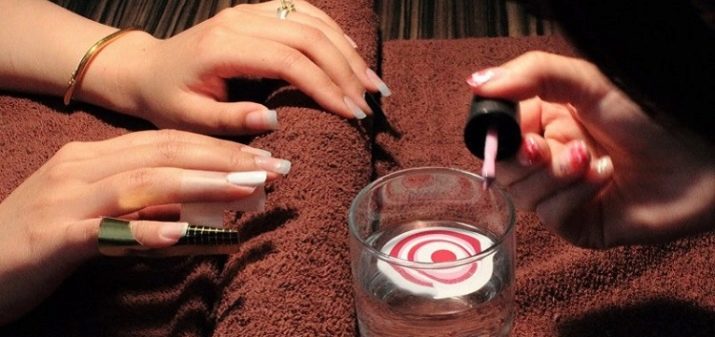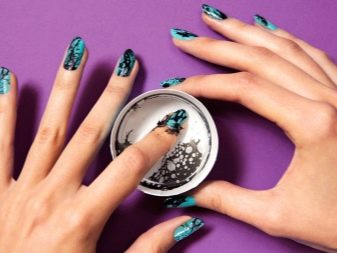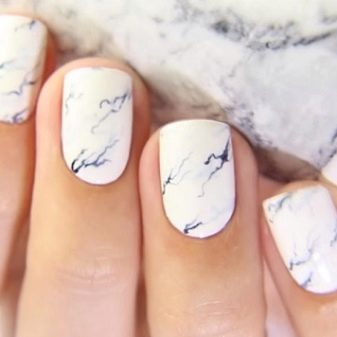“Marble” manicure is a rather fashionable and at the same time simple design that even a novice nail art master can do. In our article we will talk about the features of this technique, find out what tools may be needed in the work and how to draw an imitation of natural stone on the nails.



Features
"Marble" manicure is a stain of thin lines of several shades, seamlessly replacing each other. The beauty of such a manicure is that the same design is almost impossible to get, so your nails will always be individual. The classic version is a white background and gray-black veins.
But many masters are not limited to these colors, but recreate on their nails an imitation of turquoise, quartz, malachite and other natural minerals that have a similar pattern. All of these options also belong to the "marble" design.

What do you need?
In order to create a "marble" manicure, You will need a standard set of materials and tools.
- Degreaser - This is a special liquid that allows you to remove excess sebum that has fallen on the nail plate. Many to reduce the cost of manicure replace this tool with 90% alcohol.
- Primer - the so-called primer, which prepares the nail for applying gel polish.
- Base - this tool helps not only to smooth the nail plate before applying the color coating, but also strengthens it and prevents the pigment from moving to the nail.


- A set of matching color gel polishes - the choice of colors can be absolutely anything, as well as their hiding power.It all depends on what effect you want to get. So, using translucent jelly varnishes, you can get, for example, an imitation of quartz with visible streaks in the thickness. Gold and silver stripes can draw glittering mica, etc.
- Finish - this tool will fix the manicure so that it delights you with its pristine look for a long time. Here you can choose a top with or without a sticky layer.


- Lint-free napkins - they will help to use a degreaser, while they will not leave unnecessary hairs and villi on the nails, as conventional cotton pads do.
- Thin brush to reproduce the picture. Sometimes dots are used for drawing (metal sticks with a small ball at the end) or simple toothpicks.
- Orange stick - a tool that will help you remove excess gel polish from the cuticle.
You may also need a piece of plastic film, a bowl of water, regular nail polishes and Skin Defender (a rubber-based product to protect the skin around the nail from painting).

How to draw?
There are several types of techniques with which you can make a "marble" manicure gel polish. Consider step by step how to depict marble on the nails.
Water way
This is a fairly simple option, consisting of several stages.
- First do a manicure, carefully remove the cuticle and pterygium.
- Degrease the nail plate.
- Apply primer and base coat. Do not forget to cover the end of the nail, then your manicure will last a long time and you will avoid detachments. Dry in the lamp.
- Apply the main color coat to the entire nail. Dry again. If your color gel polish requires several coats, finish the coating to perfection.
- Next, you need to remove the sticky layer from the color coating and apply Skin Defender to the skin around the nail.

- Pour clean water into a bowl. Its temperature should be around 25 degrees. Put in the liquid those colors of ordinary nail polish that you plan to apply streaks. Using a toothpick or orange stick, create a marbled pattern in a bowl.
- Lower your fingers alternately in the water so that the nail plate horizontally rests on the drawing. In this case, with an orange stick, without removing your finger from the liquid, remove excess varnish.
- Gently with tweezers or an orange stick, detach the pattern on the nail and on the skin around it.
- Remove the Skin Defender layer. Remove excess varnish from your fingers with a remover.
- Leave the drawing to dry completely for 5-10 minutes.
- Decorate your nails with a top coating, not forgetting the ends. Dry in the lamp.




Using a plastic film
This method also does not cause problems with the reproduction of veins.
- First, we repeat step by step from the first to fifth points from the previous method.
- Then we take a color gel polish and put the drops in a chaotic manner. For example, use white and black.
- We crush a piece of polyethylene and press the drops so that they creep over the entire nail plate.
- We remove the film, remove the protective coating from the skin. Dry the shellac.
- Apply the top coat.
Another way where polyethylene can be used is to draw a picture on the film. For this, drops of gel polish are applied not to the nail, but to polyethylene. They are mixed with a sewing needle or toothpick so that the pattern resembles veins of marble. Then, with a brush dipped in a degreaser, the stains are transferred to the nail plate. After that, the drawing is dried and fixed with a top.

Drawing veins with a brush
This is the most time consuming way but the manicure is more accurate and realistic.
- Initially, it is also necessary to repeat the first four points, which are described in the water method of applying "marble" manicure.
- At the next stage, apply a layer of top on the nail, do not dry. A spreading base can also be used.
- Next, you need to mix the so-called tone nylon tights on the palette.To do this, add a drop of top coat to the gel polish with which you will reproduce the streaks. Also on the palette we put a drop of the brightest shellac.
- Now, using a brush, you need to apply a “marble” pattern to your nails.


If you have a poor idea of the location of the veins on natural stone, it is recommended to use a pre-prepared photograph of a natural mineral. This will facilitate the application of the design.
- First, with the help of a translucent tone, we apply the undermining - light, thicker lines. We apply them with a thin brush, the so-called trembling hand. If you want to leave the nail design in the color of the substrate, then you can do just a few lines. If you want the manicure to become closer to the color of the veins, then apply the pattern on most of the nail.
- Then with undiluted gel polish we draw. It should not be very much. She creates only accents. At the same stage, you can add thin gold or silver lines that recreate veins of mica in the thickness of the stone. We dry everything well in the lamp.
- At the end of the work, we make out the nails with a finish coating, sealing the end face, and dry again.
- If the top has a sticky layer, remove it with a degreaser.

Possible mistakes
Sometimes a “marbled” manicure may not work. And each method has its own reasons for this.
- In water technology, this is most often associated with inappropriate water temperature. If you took the liquid too hot, or, conversely, too cold, then mixing varnishes into the desired pattern may not work. Water temperature should be room temperature. Another reason for the impossibility of drawing a picture on the nails with a bowl of water is the too thick consistency of the varnishes. Such products do not spread well in liquids; it is simply impossible to assemble them into any pattern. Also, varnishes of different companies can "conflict" with each other, so you should choose coatings from the same manufacturer and from the same series.
- When applying a "marble" pattern using a film, the ornament may not work out due to too strong pressing on the polyethylene. Or if the gel polish turns out to be too liquid.

- When applying a "marble" mesh to the nail with a brush, you can also encounter difficulties. Do not choose too thick top coat. It will be quite difficult to draw lines on it. But a too liquid substrate is unlikely to be suitable, since it can leak under the cuticle and ruin the final result, as well as reduce the durability of the manicure.
Also, do not experiment with gel polishes from different manufacturers, as the compositions of such products may not be combined, and the coating will “curl” on the nails.

Beautiful examples
Manicure with a "marble" effect always looks stylish and fits both a business style and an evening outfit. The main thing is to choose the right combination of shades. Here are some examples of how you can beautifully design your nails in this technique.
- White "marble" on all fingers. The classic version. Suitable for business women. This design is equally good on both short and long nails.
- Classic "marble" nails on a pair of fingers can soothe an overly catchy manicure with lots of rhinestones, broths and glitter.


- On long nails, you can compose a dark and light imitation of marble, dividing them with a path of rhinestones. The result is a gorgeous, very sophisticated evening manicure.
- Delicate manicure in nude shades can also be diluted with white “marble” nails, and small silver streaks will add grace to your fingers. This option is suitable for everyday wear.


- Gold streaks on black marble is already a manicure for relaxing in a nightclub or at a party.
- “Marble” manicure looks good and with bright fuchsia nails. Only in the veins of the figure on an imitation of stone you need to add a little bright pink.


- Turquoise on the nails also looks quite elegant.In the evening version, you can add a little sparkle with a transfer foil.
- A malachite manicure in combination with gold drawings will also be a great option for the evening.


- For lovers of pink marigolds, you can choose light quartz. Gentle manicure for daily wear.
- Quartz can also be used in the design of a wedding manicure.


- The nails decorated using the marble technique can be quite bright, the main thing is to choose the right colors. For example, yellow nails with brown veins are suitable for lovers of casual clothing.
- An excellent summer option for relaxing on the sea can be a "marble" pattern on the nails in orange tones.
- White marble stains look quite interesting on glitter nails. They ennoble manicure, removing excessive shine, while maintaining tenderness.



- The sky on the nails, made in the "marble" technique, also looks very feminine and cute. To some, such a manicure may resemble sea foam. Great for summer.
- Red and black are timeless classics. "Marble" manicure can be made in this color scheme. Suitable for very confident ladies.


See how to create the effect of natural stones with gel polish in the next video.










